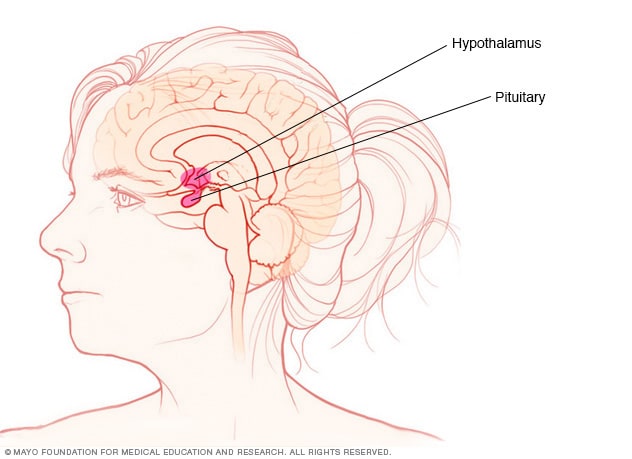Overview
Galactorrhea (guh-lack-toe-REE-uh) is a milky nipple discharge not linked to the making of milk for breastfeeding. Galactorrhea isn't a disease. But it can be a sign of an underlying condition.
Galactorrhea mostly happens to people assigned female at birth. It can happen even to those who haven't had children or who have gone through menopause. But galactorrhea also can happen to people assigned male at birth and even to infants.
Too much breast handling, medicine side effects or conditions of the pituitary gland may add to galactorrhea. Often, higher levels of the hormone involved in making breast milk, called prolactin, cause galactorrhea.
Sometimes, the cause of galactorrhea can't be found. The condition may clear up on its own.
Products & Services
Symptoms
Symptoms linked to galactorrhea include:
- Milky nipple discharge that's constant or comes and goes.
- Nipple discharge from more than one milk duct.
- Nipple discharge that leaks on its own or when the breast is touched.
- Nipple discharge from one or both breasts.
- Irregular or no menstrual periods.
- Headaches or trouble with vision.
When to see a doctor
If one or both breasts keep leaking milky discharge, and you're not pregnant or breastfeeding, make an appointment to see your healthcare professional.
If breast stimulation, such as handling the nipple during sex, causes nipple discharge from more than one duct, there's little cause for worry. The discharge most often doesn't mean there's a problem. And the discharge often clears up on its own.
If you keep having discharge that doesn't go away, make an appointment with your healthcare professional.
Nipple discharge that isn't milky needs medical attention right away. If the discharge is bloody, or clear and comes from one duct or there's a lump you can feel, it may be a sign of breast cancer.
Causes
Pituitary gland and hypothalamus

Pituitary gland and hypothalamus
The pituitary gland and the hypothalamus are in the brain. They make hormones that control many important functions in the body.
Galactorrhea often results from having too much of the hormone that makes milk when you have a baby. This is called prolactin. Your pituitary gland, a small bean-shaped gland at the base of your brain involved with several hormones, makes prolactin.
Possible causes of galactorrhea include:
- Medicines, such as certain sedatives, antidepressants, antipsychotics and high blood pressure medicines.
- Opioid use.
- Herbal supplements, such as fennel, anise or fenugreek seed.
- Birth control pills.
- A noncancerous pituitary tumor, called prolactinoma, or other condition of the pituitary gland.
- Underactive thyroid, also called hypothyroidism.
- Long-term kidney disease.
- Too much handling of the breast. This may be linked with sex activity, having breast self-exams with nipple handling or long-lasting rubbing from clothing.
- Nerve damage to the chest wall from chest surgery, burns or other chest injuries.
- Spinal cord surgery, injury or tumors.
- Stress.
Idiopathic galactorrhea
Sometimes healthcare professionals can't find a cause for galactorrhea. This is called idiopathic galactorrhea. This may mean that the breast tissue is very sensitive to the milk-making hormone prolactin. If so, even typical prolactin levels can lead to galactorrhea.
Galactorrhea in males
In people assigned male at birth, galactorrhea may be linked with too little of the hormone testosterone. Called male hypogonadism, this most often also causes breasts that are enlarged or tender, called gynecomastia. Not being able to get and keep an erection, called erectile dysfunction, and not wanting to have sex also are linked with too little testosterone.
Risk factors
Anything that triggers the release of the hormone prolactin can increase the risk of galactorrhea. Risk factors include:
- Certain medicines, illicit drugs and herbal supplements.
- Conditions that affect the pituitary gland, such as pituitary tumors that aren't cancer.
- Certain medical conditions, such as long-term kidney disease, spinal cord injury, injuries to the chest wall and underactive thyroid.
- A lot of touching and rubbing of the breasts.
- Stress.
Feb. 07, 2025